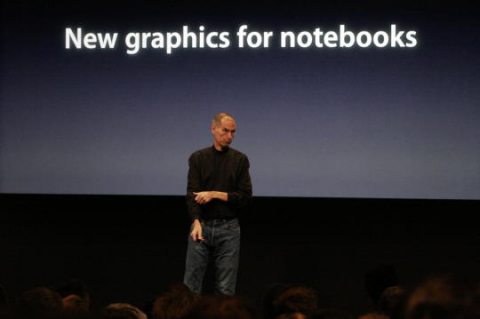LiveBlog: Apple's notebook event

update: (Editor's note: The updates of this entry appear in reverse order.)
11:03 a.m. - The event is over. Steve thanks us for coming and we're done.
10:54 a.m. Answers questions about relationship with Nvidia, as w
10:52 a.m. The video ends and Jobs opens it up to a Q&A, with caveats. No questions about the just-ended fiscal quarter (Apple reports quarterly earnings next week.) He grabs some good laughs and applause when Steve posts "110/70" on the screen. That's Steve's current blood pressure and he says that's the last question he'll answer about his health. Finally, he won't talk about the overall economy. "We're not economists. There are much smarter people to ask about the global financial meltdown."
Photo Gallery: The new MacBooks
Jason D. O'Grady: One more thing...that new MacBook
Christopher Dawson: Apple gadget lust for me, but anything for Ed Tech?
Apple's new notebooks: More coverage
10:40 a.m. - There's an upgrade to the popular consumer-oriented MacBook. First is the $100 price drop - now at $999. (There's that sub-$1,000 price point we've been hearing about.) It includes many of the same features as MacBook Pro - the unibody enclosure, the gesture-filled glass trackpad, the display, the next-gen graphics and so on - but $100 cheaper. There's also two new MacBooks - one for $1299 and another for $1599. Jobs notes that a lot of the key features on the new MacBook - the sweet spot of the market, he says - were previously only available on the $1999 MacBook Pro. Jobs calls this a $700 price drop - bringing MacBook Pro features down to a MacBook price. Following the presentation, Jobs shows a video that highlights the design, architecture and manufacturing of these notebooks.10:35 a.m. - There's an upgrade, as well, to the MacBook Air. For $1799, it has the new graphics technology, ports and so on, with a bigger hard drive, now at 120 GB. A $2499 model has faster processor and comes with a 128 GB solid state drive. There's also a new 24-inch Cinema Display, priced at $899 and available in November.
10:23 a.m. - There's a new MacbookPro. It has the unibody aluminum enclosure mentioned earlier. Jobs is so impressed that he passes around skeleton enclosure casings for those of us in attendance to touch and feel. Of course, there's that next generation graphic built-in but there's also an Nvidia 9600M GT chip. It has that new trackpad, as well. What's new on ports is a Mini Display Port, which replaces the Full-Size DVI port and all machines. The MacBook Pro is first with solid state drive offered. The notebook is .95 inches. It will come in two models. The first, priced at $1999, is a 15.4 inch LED-backlit. There's also a $2499 device, with a faster processor, bigger hard drive and more memory. They ship today and should be in stores tomorrow.
10:11 a.m. - Before we talk about Macs, let's talk a bit about design. There's some images on the screen of the skeleton of a notebook, leading up the the MacBook Air. There are some step-by-step peeks at how the aluminum casing is developed into notebook form. The company has been working hard on new unibody enclosures for new Macbook notebooks. Jobs talks about new graphics for notebooks - here comes the Nvidia logo. Jobs said they've been working with Nvidia for months and announces the GeForce 9400M chip, which combines chipset and GPU. It has 16 parallel graphics cores. He said it delvers up to five times faster graphics that what the company has been using.
There's also a new trackpad for notebooks. It's a large multi-touch glass trackpad with 39 percent larger tracking area and includes multi-touch functionality for gestures. The entire trackpad is the"mouse" button. And there's new gestures built in - using 1 to 4 fingers for zooming and so on.
10:07 a.m. - Cook continues to talk about growth of the Mac market and how sales have outpaced the industry growth. He notes that Apple has passed Dell to be top supplier of all notebooks for education. Likewise, he talks about the penetration on university campuses. Total units shipped has grown from 4.5 million in 2005 to 7.1 million in 2007. The first three quarters of 2008 is already at 7.1 million. "This is momentum," he said. And now, back to Steve Jobs.
10:00 a.m. - Steve Jobs enters from a side door but without an introduction. Says he has some fun stuff to share. There's exciting new notebooks. But first, an update on the state of the Mac, presented by Chief Operating Officer Tim Cook. Cook says the Mac has been growing 2-3 times normal. He attributes growth to better computers, highlighting MacBook Air, better software like Leopard, which Cook says is far ahead of Vista, and iLife and i Work. Also says it's due to compatibility, highlighting Boot Camp, which allows Windows to run on a Mac. He grabs some chuckles by noting that Windows Vista, which has not lived up to what it should have been, has opened doors for people to want to switch to the Mac. Marketing - as in the I'm a Mac, I'm a PC commercials - have also helped. And finally, retail stores have introduced new users to the Mac experience.
9:58 a.m. - We're live from the auditorium at Apple HQ in Cupertino. The lights dim at 9:59 a.m. - and the background classical music begins to fade out.